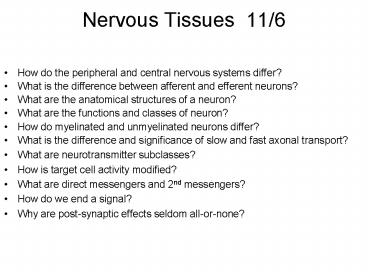Nervous Tissues 116 - PowerPoint PPT Presentation
1 / 13
Title:
Nervous Tissues 116
Description:
What is the difference between afferent and efferent neurons? ... Terminal Arborization. Axon Collateral. Neurons rarely (if ever) undergo mitosis (good and bad) ... – PowerPoint PPT presentation
Number of Views:23
Avg rating:3.0/5.0
Title: Nervous Tissues 116
1
Nervous Tissues 11/6
- How do the peripheral and central nervous systems
differ? - What is the difference between afferent and
efferent neurons? - What are the anatomical structures of a neuron?
- What are the functions and classes of neuron?
- How do myelinated and unmyelinated neurons
differ? - What is the difference and significance of slow
and fast axonal transport? - What are neurotransmitter subclasses?
- How is target cell activity modified?
- What are direct messengers and 2nd messengers?
- How do we end a signal?
- Why are post-synaptic effects seldom all-or-none?
2
Nov 11 Lab Make-up
- We do not have lab on Wed Nov 11th
- You will need to make this up on Mon, Tue, or
Thursday. Please go to a lab and ask if they can
let you in.
3
Finish notes on smooth muscle from monday
4
Our nervous system can be broken down into
central and peripheral systems based on
anatomical location.
5
Structures associated with Neurons
- Soma (perikaryon)-
- Nucleus/Nucleolus
- Endoplasmic reticulum/Golgi apparatus
- Cytoskeleton
- Microtubules and Actin/Neurofibrils
- Alzheimer Disease and neural tangles
- Plasma Membrane composition-
- Polyunsaturated FA, FA length and cholesterol
- Membrane width and separation of charge
- Baby formula FA vs. Breast Milk FA?
- Dendrite-
- Axon-
- Synaptic Knob/Terminal Button/Synaptic Node
- Terminal Arborization
- Axon Collateral
- Neurons rarely (if ever) undergo mitosis (good
and bad) - Lipofuscin indicator of aging, wear and tear
(lysosomes)
6
What are the universal properties of neurons?
What are the functional classes of neurons?
- Universal Properties of neurons
- Excitability/Irritability-
- AP Conduction-
- Neurotransmitter secretion-
- Functional Classes of neurons
- Sensory (Afferent)-
- Interneurons (Association)-
- Motor (Efferent)-
- Glial cells are not excitable (not neurons)
7
(No Transcript)
8
What are the three primary types of neuron and
what are their common characteristics?
- 1) Multipolar Neurons most common in body
- Contain many dendrites!
- 2) Bipolar Neurons associated with smell
- One main dendrite and one axon
- 3) Unipolar neurons Dendrite Axon!
- Soma is placed off to the side!
- Common Characteristics
- Established Membrane Potential
- More Na outside/K inside
- Hyperpolarized (normal is about -90mVolts)
- Excitability Ability to create/send a wave of
depolarization across the lipid bilayer of these
cells (action potential)! - This wave of self-promoting depolarization is
called an Action Potential
9
(No Transcript)
10
Neuroglial cells far outnumber neurons (501) and
are critical for the support of neuron function.
- CNS
- Astrocytes 90 of brain tissue
- Support/Protect neurons
- Blood Brain Barrier
- Ependymal cells produce cerebral spinal fluid
- Microglial cells macrophages of CNS
- Oligodendrites wrap around neurons in CNS
- PNS
- Satellite cells near soma in a ganglion
- Schwann Cells wrap around neurons in PNS
11
Neuoglial cells far outnumber neurons (501) and
are critical for the support of neuron function.
- What are the types of supportive cell for
improved AP conduction? - Oligodendrites form myelin sheath around axons in
the brain/CNS Multiple sclerosis- - Schwann cells form form myelin sheath around
axons in the PNS Nerve regeneration pathways- - Myelin sheath is very rich in polyunsaturated
fats! Sensitive to toxic lipids - Myelin Sheath does not permit electrical
conduction! - Ions cannot pass though!
- The gaps of exposed axolemma are called Nodes of
Ranvier! - Unmyelinated neurons also exist but have limits
to their function! - Especially neuronal regeneration they have no
pathway to retrace!
12
Myelin sheaths help protect neurons and helps to
conduct Action Potentials at a high rate of
speed! Neurons can be unmyelinated (slow action
potential velocity)!
13
A myelin sheath creates a pathway for damaged
axons to follow/grow into/regenerate into
following injury!Unmyelinated neurons are poor
at regeneration!































